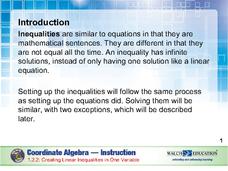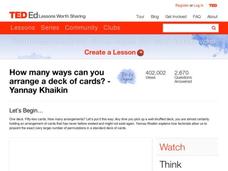Scholastic
Study Jams! Addition with Regrouping
Zoe needs to back up her music collection, but do her friends have enough space on their computers to help? Find out as you teach your class how to add two- and three-digit numbers with regrouping. Place value is emphasized as both the...
BW Walch
Creating Linear Inequalities in One Variable
Just when a young mathematician starts to feel comfortable turning word problems into linear equations, shake things up and throw inequalities in the mix. This excellent, instructive presentation takes the steps for solving an...
West Contra Costa Unified School District
Average Rate of Change
The concept of slope gets an approachable, yet theoretical, treatment in a comprehensive algebra lesson. The use of functional notation and problem-solving techniques keep the material rigorous, but detailed teaching notes and lots of...
Scholastic
Study Jams! Decimal, Fraction, & Percent Equivalents
If percents, fractions, and decimals can all mean the same number how do we go from one to another? During this instructional activity, watch how it goes over the basic steps needed to go from one rational number to the next. Both...
Intensive Intervention
Fractions as Numbers
Your learners will enjoy thoroughly understanding fractions, and you will appreciate the abundant, quality resources in this comprehensive unit that builds toward a complete understanding of the concept of fractions as numbers. Many...
Scholastic
Study Jams! Gymnosperms: Seeds in Cones
Two very hip teenagers walk through the forest collecting evergreen cones. One teaches the other about gymnosperms: cycads, ginkoes, gnetophytes, and conifers. He tries to convince his friend how amazing cones are, while she defends...
Scholastic
Study Jams! Biomes
Do you know the difference between a biome and an ecosystem? Teach elementary ecologists exactly what a biome is with this captivating cartoon! It discusses six biomes: taiga, tundra, deciduous forest, desert, tropical rainforest, and...
Scholastic
Study Jams! Plant Adaptations
Mia video chats with Sam from Hawaii! They talk about plant adaptations that allow them to live in particular environments. Examples include the flexible stems and leaves, or floating seeds and flowers of aquatic plants. The adaptive...
California Academy of Science
What's on a Penny?
As a lesson on scientific observation, have your class investigate the features of a penny and a nickel. Working in pairs, they practice writing detailed descriptions using their senses and a ruler to gather information. This is an...
Scholastic
Study Jams! Fractions
What can quesadillas teach your class about fractions? More than you might think. AJ and Zoe from the StudyJams! crew use this Mexican cuisine to explain how fractions are just equal parts of a whole, defining the key terms numerator and...
Scholastic
Study Jams! Integers
Stay positive, teaching about integers just got a little easier! Explain how positive and negative numbers are opposites using number lines and real-world examples. The included assessment provides an excellent opportunity to check for...
Scholastic
Study Jams! Properties of Matter
Does matter really matter? Properties of matter are discussed by Sam and RJ: mass, volume, and density. They differentiate between mass and weight. They explain how to measure these properties. Make sure to teach your class about other...
Scholastic
Study Jams! Heat
Raise the temperature in your class with this hot film! Cartoon teens discuss thermal energy, the conservation and transfer of energy, three methods of heat transfer, conductors, and insulators. The publisher effectively packed every...
Scholastic
Study Jams! Arthropods
No need to be crabby! Here is a resource that teaches your class about the characteristics of arthropods and provides stunning photos of several of them. In addition to the superb slides and their informative accompanying captions, the...
Scholastic
Study Jams! Properties of Addition
Zoe from the StudyJams! crew brings the properties of addition to life by clearly explaining the meaning of the associative, commutative, and identity properties as she collects photos for an album. Listen to the included karaoke song...
Scholastic
Study Jams! Expanded Notation
Teaching expanded notation is a great way to enhance young mathematicians' understanding of place value. This presentation explicitly describes the process, starting with the largest place value and working down, from left to right,...
Scholastic
Study Jams! Ratio
What is the ratio of wins to total games for Mia's soccer team? RJ teaches viewers how to figure it out with a step-by-step procedure. He shows them three different ways to represent ratios: word form, ratio form, and fraction form.
Scholastic
Study Jams! Add & Subtract Measurements
How much leopard print fabric will Zoe need to upholster a sofa for her jam studio? This problem is the example used to teach how to add and subtract measurement-related values.
Scholastic
Study Jams! Bar Graphs
Mia teaches Sam how to create a bar graph, including forming a title, creating and labeling the axes, choosing a scale, and entering data. After viewing, data analysts can test themselves with seven follow-up questions and review...
Scholastic
Study Jams! Elapsed Time
Identify the larger number, place the smaller number on the bottom, and then subtract in order to determine elapsed time. Animated slides of each step are also narrated by a friendly voice to teach elementary math minds how to solve such...
TED-Ed
How Many Ways Can You Arrange a Deck of Cards?
Entertain and grab your learners' attention with a short video clip that engagingly teaches the concept of a permutation and how a factorial is a wonderful shortcut for theoretical probability calculations.
California Academy of Science
Kinesthetic Astronomy: Longer Days, Shorter Nights
A lamp, four globes, and some signs taped around the room are all you need to set up a solar system simulation for teaching how Earth's tilted axis creates the seasons. (Sticky dots are also needed, but not mentioned in the materials...
California Academy of Science
Kinesthetic Astronomy: Moon Phases
We are the world! Each of your class members models Earth and holds a styrofoam ball to see its phases. Thorough teacher background information and a detailed lesson plan will make this a cinch to teach. If you do not want to purchase...
Royal Society of Chemistry
Types of Bonding
A covalent bond yells at an ionic bond, "Didn't anyone teach you to share?" Four matching puzzles allow pupils to review covalent, ionic, and metallic bonding. They apply logic and problem solving to complete gridlocks including the...
Other popular searches
- Substitute Teaching
- Teaching Phonics
- Teaching Main Idea
- Teaching Inference
- Teaching Volleyball
- Teaching Cause and Effect
- Teaching Point of View
- Teaching Personal Hygiene
- Teaching Poetry
- Teaching Consonant Blends
- Teaching Resources
- Nursing Teaching Plans










